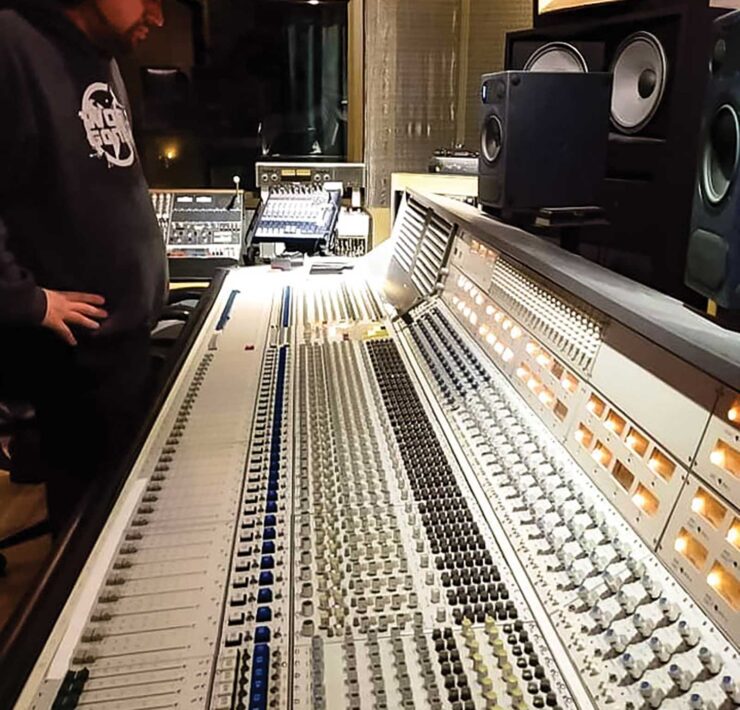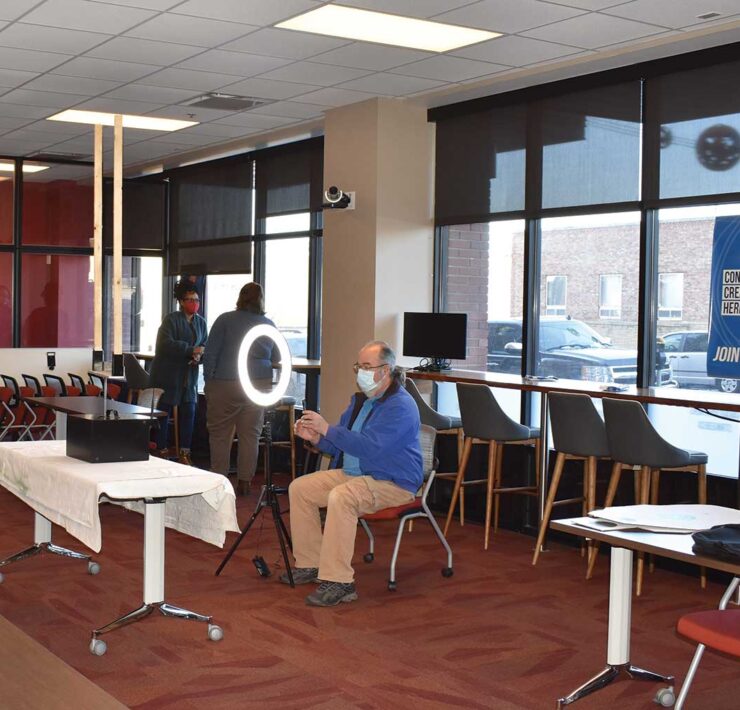Boone County Business of the Dead
Where do we go when we die? It’s something people have been trying to answer ever since we could ask the question. Many people think we go to an eternal paradise of many names. Others think we are reincarnated into another form. And still others believe we simply cease to exist. A soul is intangible, so any one of these, all of them or none of them could be right.
But this isn’t about the metaphysical. It’s about physically: Where do we go when we die?
“People have very different perspectives on what happens after death, but many people believe that their body is essentially a shell for their soul,” Scott Maddux said. As the director of the Gift of Body program at the University of Missouri — the program responsible for providing cadavers to medical classes — Maddux deals with death regularly.
“There’s a lot of taboo about it. … Most people don’t want to die, so they don’t want to think about it because thinking about it makes it real,” he told me. As I asked more questions of the people in my life about death, it became apparent that very few have any idea of the procedures of dying, something that affects us all. So my search began. Where do we go when we die?
Speaking for the dead
“That depends,” said Carl “Chris” Stacy. “Was it a natural death or an unnatural death?” Sometimes our bodies go to him. Sometimes they don’t.
Amid stacks of folders, files and forms, Stacy looked more like a bureaucrat than Boone County’s medical examiner. On his computer screen, he pointed to a picture he took in Texas of tombstones from 1918 — the days before his profession gave us answers — and told me there must have been some reason so many people in this cemetery died all at once. He told me that’s why he does what he does.
“It’s so important to know why people die,” he said. A lot of times, Stacy is the only person who can speak for the dead. “Obviously, that person can’t say they were shot and how it happened or if they had severe chest pains.”
When people die naturally and under the care of a physician, Stacy simply signs the death certificate. But when people die in a suspected accident, homicide or suicide; die under suspicious circumstances; are younger than 18 years of age; or may constitute a threat to public health, Stacy is an integral component of the process.
As soon as the death is known, Boone County’s Death Investigator Dori Burke arrives at the scene to take notes that might provide clues for Stacy. If Stacy can determine the cause of death based on the notes alone, the body is released to the care of the family. He said this happens in about 70 percent of his cases.
Ninety-five percent of the remaining cases are subject to a full autopsy, Stacy said. A handful of funeral homes are contracted to bring the remains to the morgue, which is located in the basement on the south side of University Hospital. That’s the most professional way to do it, he told me. Although Burke has a license to transport remains, Stacy said the possibility of having a motor pool with vehicles and drivers available 24/7 through his office would be impractical. “And I don’t want to take away the funeral homes’ business,” he added.
Stacy told me he also takes cases from outside of Boone County. In nearby counties, the coroner will bring the bodies to Stacy for an autopsy. Unlike Stacy, who’s appointed by the county commissioner, coroners are elected and are not required to be forensic pathologists such as Stacy. Sometimes they are farmers; a lot of times they’re funeral directors. In places such as Boone County, which has a higher-than-average population, medical examiners are the norm.
Greene County, in southwest Missouri, also contracts with Stacy to complete about 200 cases each year after having difficulty attracting its own medical examiner. A Greene County funeral home is contracted to bring those remains to Columbia for an autopsy. But Stacy’s currently working on a research project to decrease the number of bodies that need to be transported that far. So far, more than 20 cases have been managed over a secure telemedicine line, and that includes allowing police in outlying counties to watch an autopsy remotely to collect evidence.
But there are a lot of shortcomings Stacy noted about the procedure. “We’re still confident with our results, but sometimes I’d like to do more tests.” I think about the picture from Texas before I nod my head in agreement.
Because X-rays are expensive, Stacy tends to use them sparingly and mostly on cases in which there might be a projectile inside the body (or in non-pathologist speak, a bullet). If the morgue had a CT scanner or other radiology equipment, Stacy said he would be able to take more cases. “But counties can’t afford that,” he added. Even now, the medical examiner’s office doesn’t break even on autopsies. It charges the county $1,300 each but is considering increasing its rate to $1,500 to cover expenses. He, himself, is also an MU employee, and his teaching counts as part of his medical examiner salary.
Despite the cost issues, though, Stacy reiterated how important this is for families and friends to receive closure, even if expectations are often higher than what his office can deliver.
“People see shows where DNA tests take an hour, but for us it takes three days,” he said. “NCIS is the closest [to reality], but all [TV shows] take a lot of liberties.” Even still, because most people don’t deal with death on a daily basis — beyond, perhaps, tuning into a Criminal Minds marathon every once in a while — TV shows may be all we can relate to.
“When people ask me what I do, I typically don’t say much,” he told me. “Or I’ll say I do what Ducky does on NCIS.” Then, a picture on the slides he’s sharing with me catches his eye.
“Doesn’t that look human?” he asked as he pointed to a picture of a severed hand.
“It does to me, I guess, maybe,” I replied, as non-committal as possible.
“That’s actually a bear claw, but you couldn’t tell without an X-ray,” he said before turning back to my notebook and me.
“If someone is interested in what I do, I’ll go into as much detail as they want,” he said. “But most of the time, I find that less is more.”
Two ways to die
“That depends,” Lori Kramer Clark told me, “on the type of death.” As the hospital and family services coordinator at Midwest Transplant Network, Columbia’s only organ procurement organization, she was sure to call each and every organ and tissue donation a gift. That’s what it is to the more than 115,000 Americans in need of a transplant. In 2012, Boone County hospitals facilitated 25 organ donors out of the 209 total in the Midwest Transplant Network’s service area.
But even she got skittish sharing the details with me over the phone. That’s understandable; it’s a sensitive subject. So we used convoluted terms and explanations to treat the subject matter as sensitively as possible.
Few people know that there are actually two ways to die: There’s cardiac death — something we’re all a bit more familiar with — and brain death. “[Brain death] doesn’t mean that a person is any less dead or ‘sort of’ dead,” she said. It just means that oxygen is no longer being carried to the brain to allow it to function.
“A lot of [people] out there think it doesn’t matter how they die because they want to be an organ donor no matter what,” she told me, but it does matter. When someone is brain dead, it’s possible for full organ donation, including the heart, lungs, etc. Someone who had suffered cardiac death can still donate tissue, but that’s different.
In the case of a full organ donation, the first thing that must happen is while the patient is still in the intensive care unit, the donation team checks all organs for full functionality. The team will also register the donor with UNOS (United Network for Organ Sharing), which will generate a list of potential recipients, and the Midwest Transplant Network will work its way down the list, from the top, until a viable recipient is recognized and his or her doctor is contacted.
Clark explained there is more than one way that organs can be provided to recipients. In some cases, with particularly time-sensitive organs such as thoracic organs, including the heart and lungs, the recovery surgeon will fly into Columbia Regional Airport, ride in an ambulance to the hospital and perform the removal and packaging in the local operating room before flying back with the organ. For abdominal organs, it’s possible that a local recovery surgeon may perform the removal on behalf of the distant transplant center, which may send an empty charter plane to retrieve the organ. It may not be possible to send thoracic organs as far as, say, California, yet organs can and often do save lives all over the country.
Following solid organ removal, or after a cardiac death, donors are transported to Kansas City for tissue donation. Midwest Transplant Network has its own recovery suite for tissue retrieval, which allows for a timelier and more seamless recovery, Clark said. After the donation is complete, the donor is returned to the funeral home the family has chosen.
In 2012, the Midwest Transplant Network received an award from the Health Resources and Services Administration for reaching a donation rate of 75 percent among eligible donors in its service area. That meant 25 organ donations in Boone County out of the network’s regional total of 209.
But if you’re thinking about donating or plan to donate, Clark asks that everyone have that hard conversation with your family and friends: Where do I want to go and what do I want to do when I die?
Donation to learn
“That depends,” Maddux, with MU’s Gift of Body program, told me when I asked him where we go.
“There are a lot of important decisions that are made after someone passes away,” he said. “[Deciding in advance] makes it easier on the family and lets them know they’re doing the right thing.”
“To make use of their body to help their fellow man, I think, is a great way to benefit mankind after you’re gone,” he told me. Typically, he said, donors to the program fill out the form online, provide documentation to family and friends and put their wishes in their wills. “But if at any point the family decides they’d rather not donate the body to science, we always respect those desires.” It’s possible to have a funeral before the body is passed over to the program, and all the family has to do is provide transportation of the body to the facility.
Although most of the donors live in mid-Missouri, sometimes Maddux will get donors from out of state. Typically, they had lived in mid-Missouri, signed up for the program and moved. Even in this case, it’s still possible to be a part of the program, as long as the family pays for the body to be returned to the area.
Because most of the donors are from the area, there are certain precautions that must be taken. When Rick Baker, a helicopter medic for University Hospital, went to MU in the mid-’80s, they had to be sure he would not be matched with his grandfather, who had donated his body to the program years before. Although I felt bad asking, I had to know how could MU be sure of this.
“They just ask you,” he said. “Have you been close to anyone who has recently donated his or her body to science?” I felt a little more comfortable that I asked, too.
After the body is properly embalmed, it’s used for educational purposes for first-year medical students. “To become a doctor, it’s so important for [the students] to understand how the body is set up,” Maddux said. “Even with realistic computer simulations, they can never be quite like the 3-D representation from dissection-based anatomy.”
Because proper organ placement is vital to the students’ ability to learn, bodies that have undergone an autopsy or have suffered severe trauma can’t be donated to the program.
Each year, between 50 and 60 cadavers are necessary to meet the need of MU’s medical and physical therapy students, four of which share in dissecting each cadaver. Until they are needed, the cadavers are held in a special unit of the morgue after their embalming.
“And our medical classes have been increasing in size, so our need [for cadavers] has been increasing along with that,” Maddux said. The number of first-year medical students has hovered around 100 for decades, but now that a fourth-year elective class has incorporated cadavers, the need has increased. Typically, the program meets its needs each year without falling under or going too much over. “In some cases, if we do go over, we may not dissect them for two years but will keep them for that time so the deceased’s wishes will be respected,” Maddux said.
If the program were ever to fall short, there are options through the Missouri State Anatomical Board to request additional cadavers from other universities. St. Louis and Kansas City schools, because of higher populations, typically have more donors. If another university were to fall short, MU could also provide extra cadavers, which are later returned and cremated exactly as if they had been used in an MU course. The remains can either be returned to the family or interred into a burial plot the program has. “The plot is just a gift we can give them for the gift they’ve given us,” Maddux said.
Every year, to remember the gifts of each of the people who’ve chosen to donate their bodies to the program, the medical school holds a memorial service. “It’s a time for all medical students…to reflect on how important that class was for them,” he said. “When they first come in, they’re not aware of how much they’re going to learn, but by the end of that year, they can truly reflect on how much they’ve learned from these people who have very graciously allowed these students to learn.”
Just part of the job
But where do people go if they don’t donate organs or their body or they don’t undergo an autopsy? Where does someone go if, you know, he or she just dies?
“As soon as the medical examiner releases the body, we go to pick it up,” said Bruce Rice of Parker Funeral Home. This would be for cases that have been pre-arranged or the family has contacted the funeral home after the death certificate has been signed. They’re taken to the embalming room at the funeral home, and Rice and his colleagues begin planning for the final goodbye.
“We’re in touch with the family to see what kind of arrangements they want, and we meet with them to discuss the information for the death certificate and obituaries,” Rice said. “There’s a lot of things people don’t know about my line of work, but I don’t call anything I do weird. All we’re doing is offering a service to families.
“There are a lot of unknowns to people, so their perception of what I do may be weird, but it’s just a part of my job.”







